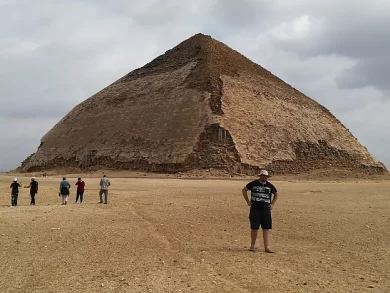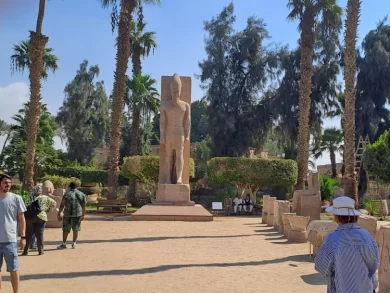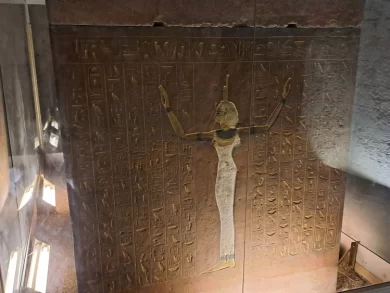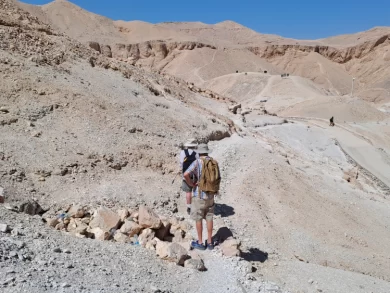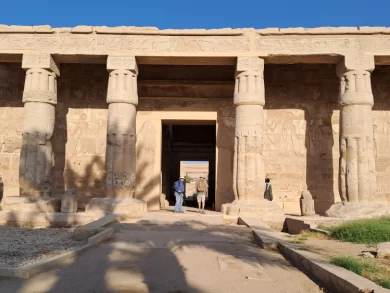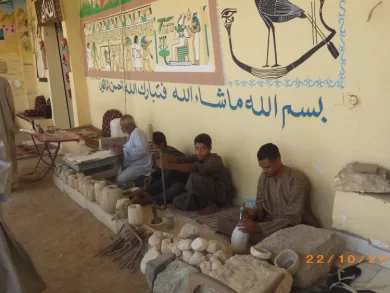Our last day in Egypt. After last night’s escapades, it took some effort for everyone to drag themselves to a 7am rooftop breakfast, where we were greeted by a haze which completely hid the view of the Giza Pyramids. Breakfast was interesting as the waiter person had less English than we had Arabic, but eventually we were all fuelled for the coming day.
Our guide and driver were due to fetch us at 8, so packed, fed, and now wide awake, we headed downstairs to wait. Unfortunately, our driver had the address of the place I had originally booked which necessitated some frantic phone calls. Sitting on the curb outside the hotel we managed to witness what seemed like the entire Giza collection of camels come thundering past us, along with horses and the odd tuk-tuk going in the opposite direction. Chaos!
After some rerouting due to the GEM roadworks, we arrived at the ticket office. Two of the Luxor Mob had decided they would do the interior of the Great Pyramid. I know it is not the easiest of things to do, so, well done to them.
I have to say that the area in front of the Great Pyramid is much cleaner than it has been in the past, and the number of hawkers was really at a minimum and didn’t bother us at all. It was also good to see the police getting strict with people climbing onto the monuments for photos.
Once our intrepid two had returned, we set off for the observation point, but elected to get out of the minibus about halfway and walk back to the Menkaure Pyramid. A nice little walk and fabulous views of the Khafre and Menkaure edifices. Again, people climbing the side of the pyramid was an issue until officials got involved.
Our driver and guide collected us, and we made our way to the Sphinx area. This now involves driving round to the far side of the Sound and Light seating and approaching through a small run of shops to the south of the famous statue. As always, the Valley Temple was full of tourists and the viewing point by the Sphinx even more so. Good to be back here.
Next stop was lunch. A Syrian street food restaurant that I definitely want to go back to. It will be on the next tour as a definite lunch stop.
Everyone full to bursting, we made our way to the Egyptian Museum in Tahrir Square. A lot of work going on in the gardens, but all hidden behind hoardings. The use of a guide microphone and earpieces works really well and does much to keep the noise levels down inside the museum, although it does mean you have to keep up with your guide.
The museum is looking much better with its recent paint job, some better lighting, as well as a lot more information cards. To all those people who are saying that the museum has been emptied, I would like to say that they are very wrong, there is still much to see including a lot of the Tutankhamun collection, especially the jewellery and the funerary mask. The golden throne is still there as well as many other artefacts. Also, really nice to see the Yuya and Thuyu items beautifully displayed. The Menkaure triads are also well represented. So much to see, so little time.
Do not put off going to Egypt because the GEM is not yet open, the Egyptian Museum in Tahrir has more than enough to look at, and of course there is also the NMEC. Spoilt for choice.
Time to go, saying farewell to our guide, we began the trip back to Cairo International and our flight home.
A great tour, and on a personal level, a fantastic opportunity to return and say thank you to all those people who were so magnificent to us in 2020. I won’t name names, but you know who you are. Thank you, Egypt.



